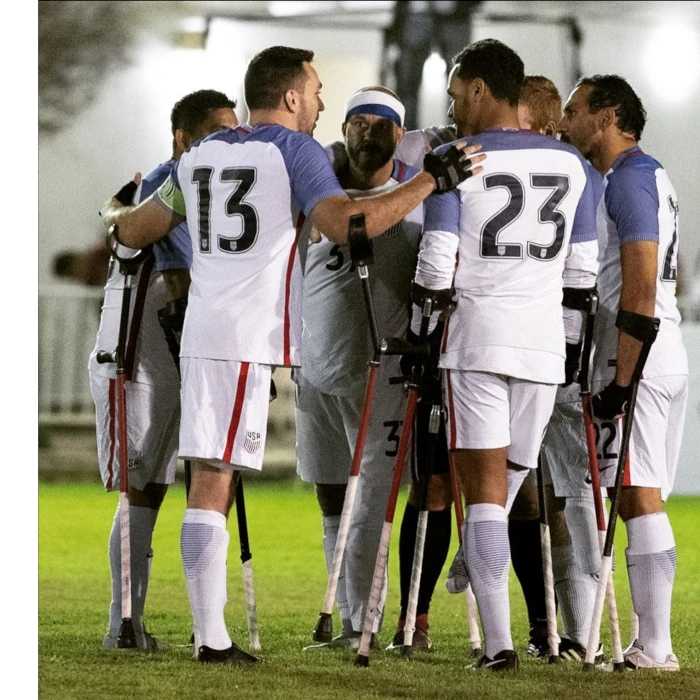
By the time you read this, it’s possible the US Amputee Soccer Team will already be eliminated from this year’s World Cup tournament in Istanbul. After emerging from pool play with a strong 2-1 record (including an upset win over England), Team USA played Haiti this morning in the first knockout round. Should they advance, they’ll play the winner of Japan-Tanzania in the quarterfinals; another win would likely pit them against the defending Amputee World Cup champs, Angola, in the semis.
Win or lose, this has already been a successful season for the American side. They earned their spot in the tournament by finishing second in the North and Central American regional qualifier, placing ahead of the powerful Mexican team and winning a head-to-head match against Haiti. In World Cup pool play, Team USA’s goal differential (+4) ranked as the sixth-best among the 24 entrants. Even their lone defeat in pool play, a 3-1 loss to Argentina, was a moral victory—a competitive game against a team with a distinguished Amputee World Cup history.
If you’re not familiar with the American players (and we bet you’re not), here are some interesting facts about the team and the sport to pique your interest for what we hope will be a lengthy tournament run.
1. Amputee soccer was born in the United States.
It was invented in the early 1980s by Don Bennett, a Seattle amputee skier who organized local soccer games to stay active in between snow seasons. Bennett is credited with codifying the rules, which call for seven players to a side, a pitch that’s 75 percent as big as a regulation soccer pitch, and a requirement that participants use forearm crutches for mobility, rather than prosthetic legs. Goalkeepers must be upper-limb amputees, defending a 7’x16’ net. The first international amputee soccer tournament was held in Seattle in 1984, with Bennett serving as the US team manager.
2. US team captain Nico Calabria has emerged as one of the world’s best amputee soccer players.
With four goals in pool play, Calabria is currently tied for second place in Amputee World Cup scoring, trailing only Angola’s José Candeiro Jamba (who has sent five into the net). Calabria also starred at the North and Central America qualifying tournament, where he was named Most Valuable Player. By raising his own game to an elite level, Calabria has helped elevate the US team as a whole. “Thinking about where we are now compared to where we were when I joined the team in 2012 is a night and day difference,” he wrote last month on Instagram. “As the competition has grown around the world, we all have had to increase our effort to meet that challenge.” Calabria has
3. Team USA has never won the Amputee World Cup.
Despite being the cradle of amputee soccer, the United States has never claimed the title in the sport’s premier event. Its best finish came in 1988, when the US finished third in a six-team field. The following year Russia, Uzbekistan, and Brazil established national amputee soccer teams; those are the top three medal-winners in international competition over the last 30 years. The African continent produced several powerhouse teams in the early 2000s, and this year’s host nation of Turkey has become a global titan in the last decade (including a second-place finish at the 2018 Amputee World Cup).
4. The 2014 and 2018 US Amputee World Cup teams included Josh Sundquist on the roster.
This is among the least-known talents of our July cover subject. Athletically, Sundquist is best known as a skier (he competed in the 2006 Winter Paralympics); he has since gone on to renown as the King of all Media (books, public speaking, Halloween supremacy, Instagram, TikTok, and now television). But in a 2018 blog post, Sundquist reminisced that the same week he got the cancer diagnosis that culminated in removal of his left leg, he’d been attending tryouts for a youth soccer team. “I loved the idea of traveling to other towns, competing, and most all wearing a uniform,” he wrote. “To be able to play as a member of the US Amputee Soccer Team (which I think qualifies as a travel soccer team, right?) and to be able to rep this uniform is not only a great honor, it’s the realization of a dream I thought I’d lost.”
5. Two teenagers made the US team.
Amputee soccer is enjoying a renaissance in the United States. Nico Calabria has had a lot to do with the resurgence. In addition to making Team USA more competitive, Calabria has tirelessly promoted the game all over the country. The US national team is now supported by six regional squads that recruit and develop talent. Those efforts are already showing results, in the form of 16-year-old Kavi Pandya and 18-year-old Amİe Donathan, both of the Lone Star Adaptive Soccer Association. They and other young players represent the game’s future in the US.